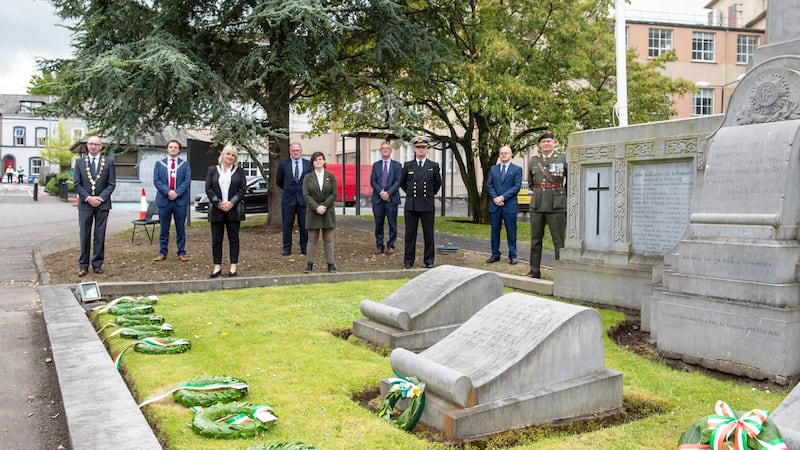It could be argued that the execution by the British of 13 IRA volunteers in Cork 100 years ago was a war crime, according to a University College Cork historian.
Speaking at a ceremony in UCC at the mass grave where the men were buried, Gabriel Doherty of the School of History at UCC said the executions of the 13 men, captured in Cork, Tipperary and Limerick in 1921, was the result of the British resorting to state-sanctioned legal violence to counter the IRA.
He recalled how the Restoration of Order in Ireland Act of 1920 imposed the death penalty for a range of offences including possession of firearms, which was designed to stop the IRA guerrilla campaign in its tracks.
"Munster experienced the most dynamic and effective armed resistance on the island and in December 1920, the British government placed the province under martial law, administered by a military governor in Victoria Barracks.
“It was this regime that condemned 13 IRA volunteers, unfortunate enough to be caught in the nets of the British military,” said Mr Doherty, who is on the advisory committee to the Government on the decade of commemorations.
The executions, which took place by firing squad in the Cork Detention Barracks inside Victoria Barracks, began on February 1st, 1921 with the execution of Captain Con Murphy from Millstreet, who was caught with a loaded pistol.
On February 28th, five IRA men captured at the Dripsey Ambush, volunteers, Patrick O'Mahony, Timothy McCarthy, John Lyons, Thomas O'Brien and Daniel O'Callaghan were all shot together with Capt Sean Allen from Co Tipperary.

On April 28th, four IRA men, Volunteer Maurice Moore and Lt Patrick Sullivan from Cobh, both captured at Clonmult and volunteers Thomas Mulcahy and Patrick Roynane, both from Burnfort and captured at Mourneabbey, were shot.
Just a few days later on May 2nd, Volunteer Patrick Casey from Grange in Co Limerick was executed with the final execution taking place on May 16th when Volunteer Daniel O'Brien from Liscarroll in north Cork was shot.
“Many had been captured fighting with the IRA Flying Columns in well-known engagements such as Dripsey, Mourneabbey and Clonmult,” said Mr Doherty. “Others were caught amid the daily peril of their national service.
“Their social backgrounds were modest – among the 13, one could find tram and creamery workers, an apprentice plumber, a shoemaker, clerks, a World War one veteran – they were ordinary people caught up in extraordinary times.
“The execution of Prisoners of War , for these volunteers buried here undoubtedly were [POWs] as British courts at that time clearly affirmed, is always a foul deed. Legal scholars might deem it a war crime.”
Memorial
The bodies of the 13 men were taken from Victoria Barracks, now Collins Barracks, and buried at Cork Men’s Gaol, which was later acquired by UCC, and they are commemorated with a memorial over the plot on the college campus.
Interim UCC President, Prof John O’Halloran said the denial of a public burial of the 13 men and their interment behind the prison walls by the British in the former exercise yard of Cork’s Men Gaol was intended as “a final punishment.”
But despite that, the grave, now the largest mass grave in the country of IRA men executed during the War of Independence, has become a site of national memory, following UCC’s acquisition of part of Cork Men’s Gaol in 1946.
"Old IRA veterans raised funds to construct a suitable public memorial and in 1948, Eamon De Valera unveiled this monument and the adjoining Seamus Murphy plaque at the front of the gaol," said Prof O'Halloran.
According to UCC historian Dr John Borgonovo, of the 24 official executions carried out between 1919 and 1921 during the War of Independence, 13 were in Victoria Barracks in Cork, 10 were in Mountjoy and one was in Limerick.
Wreaths were laid by the Mayor of Co Cork, Cllr Mary Linehan Foley, Deputy Lord Mayor of Cork, Cllr Shane O'Callaghan and Mayor of Limerick City and County, Cllr Michael Collins, as the names of the executed men were read out by third-year UCC history student Alana Daly Mulligan.
Colonel Ray O'Lehan, representing Brigadier General Brigadier Brian Cleary, of 1 Brigade, Collins Barracks and Commodore Michael Malone, Flag Officer Commanding the Naval Service, also attended the wreath-laying ceremony.
Descendants of the executed men were also present for the event, which was introduced by Dr Mervyn O'Driscoll of the School of History at UCC and which closed with Amhrán na bhFiann played by uilleann piper Nichola Stathers from the UCC Academy.










